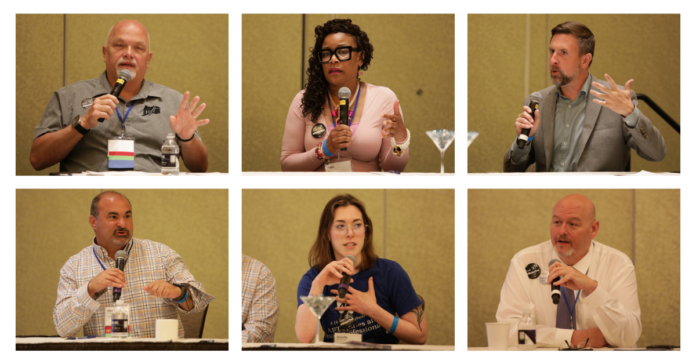A unique panel discussion with local affiliated union leaders on internal organizing was a focal point at AFT Connecticut’s annual convention last month. Five affiliates representing each of our state federation’s jurisdictional divisions were showcased for effectively engaging members early and often to build and maintain strength and maintain density. Together, they provided a blueprint for our labor movement to not just survive, but thrive in a challenging and uncertain legal and political climate.
The 2024 convention brought more than a hundred delegates representing AFT Connecticut’s nearly 34,000 members to the Mashantucket Pequot Tribal Nation’s Foxwoods Hotel Resort. The panel, led by Organizing Director Eric Borlaug (top row, far right, in collage, above), was a first-of-its-kind effort at the annual event to provide participating leaders with tangible training and concrete counsel.
The purpose of the discussion was to share best practices from local unions who have reached and consistently maintained membership density of 90 percent or higher. The goal has been particularly important for our affiliates representing working people in the public sector since the U.S. Supreme Court’s Janus decision in 2018.
Click here for our previous report on initial efforts to overcome the impact of the high court ruling.
“As much as Janus created headaches, it’s made us move and be better at our job,” University Health Professionals (UHP) President Bill Garrity, RN (bottom row, right), told delegates. “It’s made us proactive in gathering information on potential members and forced us to use all the tools that are in play to make consistent contact,” he added.
Garrity’s comments were echoed by fellow panelists who additionally stressed the importance of local leaders tapping multiple tactics as part of a “seven asks” approach to recruitment.
Hope Wyatt (top row, middle), the president of our Norwalk Federation of Education Personnel, shared how labor leaders have partnered to support each other’s efforts. “We’ve created a coalition of all district union presidents to work together on common issues like recruitment, to make sure we don’t miss anybody,” she said. “We go right to new hire orientations together and invite new employees to be members.”
Click here for more on how the state’s labor movement is collaborating to engage current and new members.
Administrative & Residual (A&R) Employees Union President John Disette (bottom row, left) credited their success to engaging worksite-level leaders in the mission of recruitment. “We have signed up over 800 new members within the last year and a half,” he told delegates. “We share all new hire data with our stewards so we never lose track of those who’ve not yet joined.”
A private sector union leader on the panel shared how deliberate efforts to broadly increase union participation have helped boost success in their recruitment of new employees, too.
“Recently, our executive board has been getting rank-and-file members more involved,” Backus Federation of Nurses Vice President Danielle Berriault, RN (bottom row, middle), told delegates. “Whether it’s learning about Weingarten rights or taking part in the grievance process – it’s like exercising at the gym and really taking charge of their role in the union.”
Click here for analysis of efforts to resist private sector restrictions like those imposed by the Janus decision.
State Vocational Federation of Teachers President Paul Angelucci (top row, left) stressed the need for fellow labor leaders to “play the long game” when it comes to strengthening their local unions. “It’s about seeing new hires’ potential not just to be members, but to be great activists in the future. That means personally reaching out, making that connection and asking them to step up.”
Collectively, these five union leaders painted a hopeful and inspiring picture of membership engagement and workplace activism in the wake of the Janus decision. They have shown how to effectively overcome the special interests who initially bankrolled the lawsuit in an attempt to hobble America’s labor movement.
Those same forces have spent the past five years exploiting the high court ruling to achieve their aims through a dark money-funded, nationally-coordinated campaign. Earlier this summer, they re-launched an “opt-out” scheme in Connecticut, harvesting local union members’ personal information in order to target them with deceptive propaganda.
Click here for press reporting on our national union’s recent legal success shielding members from these tactics.



